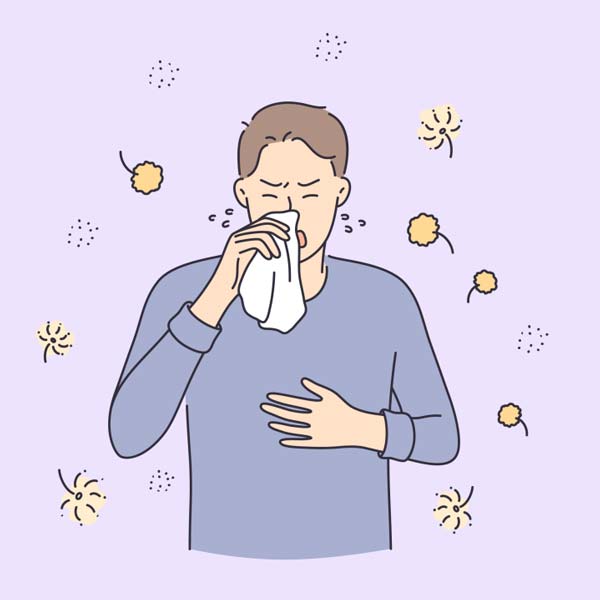◆ What is autumn allergic rhinitis?
Autumn allergic rhinitis is a type of allergic rhinitis, a chronic reactive inflammation of the nasal mucosa. It is a seasonal, paroxysmal rhinitis usually caused by pollen.
Allergies are essentially an exaggerated immune response to certain substances. Pollen, a common allergen, stimulates the body to produce specific IgE antibodies upon initial contact with the nasal mucosa, binding to the mucosa and its surface cells. This sensitizes the nasal mucosa.
Subsequent exposure to pollen triggers an overactive immune response in the surface cells of the nasal mucosa, leading to symptoms such as increased secretions, sneezing, itching, and nasal congestion. Allergic rhinitis episodes are time- and location-specific and are easily affected by certain meteorological factors.

◆ How to distinguish between "allergies" and "colds"?
Like colds, allergic rhinitis can also present with symptoms such as nasal congestion and temporary olfactory impairment. The difference is that allergic rhinitis often presents with nasal itching, sometimes accompanied by itching in the eyes, external auditory canal, soft palate, and pharynx, as well as red eyes, tearing, swollen eyelids, and a dry cough.
Allergic rhinitis typically causes multiple sneezes, often occurring reflexively in the morning, at night, or immediately after exposure to allergens. The nasal discharge is watery and, in severe cases, can flow spontaneously, requiring constant wiping with tissues, even disrupting daily life and school. Some patients experience coughing after lying down, which is also sometimes due to allergies causing mucus to back up into the throat.
◆ How to treat autumn allergic rhinitis?
If the aforementioned allergic rhinitis symptoms appear in autumn, you should immediately leave the environment causing the allergy and seek professional medical treatment. Currently, common medications include nasal corticosteroids combined with antihistamines, mast cell membrane stabilizers, anticholinergics, antileukotrienes, nasal decongestants, and pollen blockers (physical barriers, similar to wearing a mask). Follow your doctor's instructions for specific medication selection and dosage. If you need to add medication or have other new needs, consult your doctor and pharmacist promptly.

◆ How to prevent autumn allergic rhinitis?
Minimize outdoor activities. Avoiding exposure to allergens is the most direct and effective preventative measure. Pay close attention to pollen forecasts near your area. Minimize outdoor activities. Even if you need to go out, wear a mask to avoid inhaling pollen, which can trigger allergic rhinitis.
Rinse your nasal cavity. After returning home from an outdoor activity, rinse your nasal cavity with sea salt water. This can reduce the amount of allergens adhering to the nasal mucosa, thereby alleviating allergy symptoms.
Eat a balanced diet and exercise regularly. Drink plenty of water, consume fresh vegetables and fruits, supplement with vitamins, maintain a balanced diet, and maintain necessary physical activity to boost your immunity and reduce the frequency of allergic rhinitis attacks.
Warm reminder: With allergy season approaching, seeking formal medical treatment is the first choice. Avoid purchasing medication on your own, as this may delay optimal treatment.

%20--%3e%3c!DOCTYPE%20svg%20PUBLIC%20'-//W3C//DTD%20SVG%201.1//EN'%20'http://www.w3.org/Graphics/SVG/1.1/DTD/svg11.dtd'%3e%3csvg%20version='1.1'%20id='图层_1'%20xmlns='http://www.w3.org/2000/svg'%20xmlns:xlink='http://www.w3.org/1999/xlink'%20x='0px'%20y='0px'%20width='256px'%20height='256px'%20viewBox='0%200%20256%20256'%20enable-background='new%200%200%20256%20256'%20xml:space='preserve'%3e%3cpath%20fill='%23FFFFFF'%20d='M194.597,24.009h35.292l-77.094,88.082l90.697,119.881h-71.021l-55.607-72.668L53.229,232.01H17.92%20l82.469-94.227L13.349,24.009h72.813l50.286,66.45l58.148-66.469V24.009z%20M182.217,210.889h19.566L75.538,44.014H54.583%20L182.217,210.889z'/%3e%3c/svg%3e)